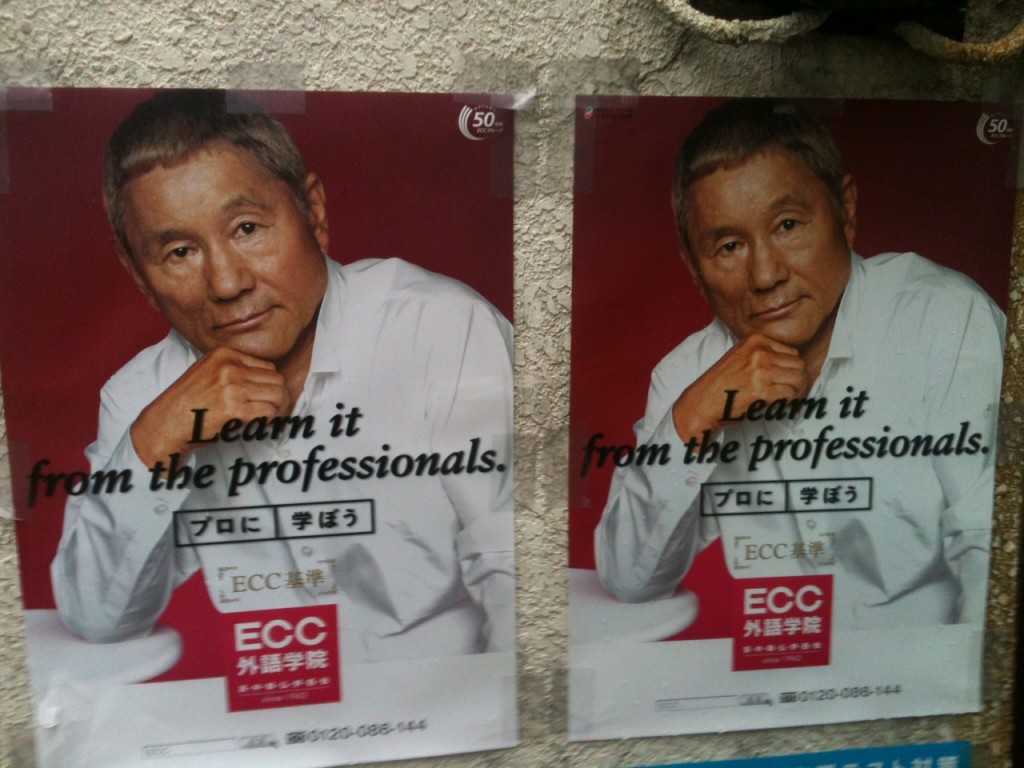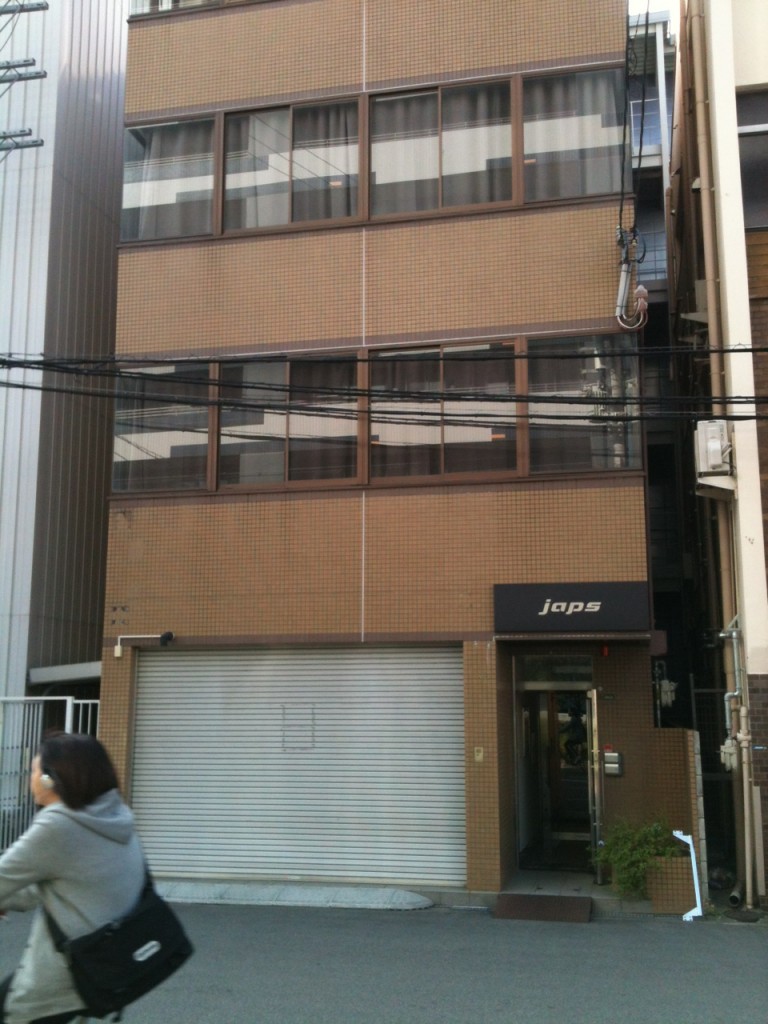
Scott Adams once posted this tip for getting to sleep:
Don’t think words.
By that I mean don’t imagine conversations that you plan to have, and don’t replay in your head conversations you’ve had.
It’s impossible to clear your mind of all thoughts. But I find it somewhat easy to switch off the language center of my brain. What happens after that is a flow of images, starting with ones that make some sense to my current life, quickly followed by randomness, then sleep. It usually takes less than a minute.
Given how many western filmmakers depict the country as a waking dream, maybe it stands to reason that I also found this technique applicable while walking through Japan. On a purely linguistic level, understanding Japanese (or Korean, or Spanish, or whichever) gets easier when I simply shut off my mind’s instinctive flow of English-language commentary. But I also seem to perceive the Japanese urban environment more richly when I restrict my thoughts to the non-linguistic. “It’s a visual culture,” many of the resident expats I met told me, and I figured I’d approach a place that supposedly thinks primarily in images by thinking primarily in images myself.
“Appearances are reality,” Donald Richie writes of Japan in The Inland Sea. “The mask is literally the face, and the cynic can find no telltale gap because none exists.” Though this element of Japan divides observers, I personally find it one of the most compelling reasons to go. I’ve long felt, but now understand, a longing to enter a realm where nobody prattles on about the supposed divide between one’s embodiment, one’s behavior, and who one “really is.” I can’t imagine a Japanese person seriously throwing around accusations of “pretension,” a charge that even in America says nothing about the accused but everything about the accuser.
Perhaps we’d do better to call it a formal culture than a visual one. “The Japanese are a people who have managed to retain, right into the latter half of the dehumanized twentieth century, a very human, even primitive quality: their innocence,” Richie writes later in the book. “While this does not prevent great subtlety and a degree of sophistication, this mighty innocence — one that the Japanese share with what those white man elsewhere calls natives — rests upon an uncompromising acceptance. The innocent does not look for reasons behind reasons. He, secure in the animal nature that all of us have and only half of us admit, is able to see that all reality is what the West finds merely ostensible reality. Reality is only skin deep because there is only skin. The ostensible is the truth.”
Or, as one interviewee, an Englishman who’s spent 25 years in Japan, said to me: “You know how you can tell an artist in Japan? They’re the ones wearing berets.” He wasn’t joking. Another day I climbed to the top of a mountain with another interviewee, another westerner. We watched, in our everyday clothes and shoes, as Japanese hikers passed by dressed in full outdoorsman’s regalia. They all but wore Tyrolean hats — and some of them may well have worn Tyrolean hats.

The aggrieved periodically e-mail me to complain that I interview too few women or minorities or what have you. Wait until they get a load of my conversations from Japan, conducted with a veritable murderer’s row of mostly middle-aged, often English, men. While happy indeed with how these recording sessions went, I do regret that not one Japanese person consented to sit at the other end of the microphone. Knowing full well that that the clearest-eyed perspectives on a place do come from outsiders — Englishmen, from Christopher Isherwood to Reyner Banham to David Hockney to Richard Rayner, having also offered the most enduring views of Los Angeles — I’ll still look harder next trip.
But from what I’ve heard, few Japanese people, no matter how polished their English, will willingly speak it in anything like an official context. Pico Iyer, in The Lady and the Monk, wrote perhaps the funniest and most cringe-inducing illustration of this phenomenon when recalling the time he was forced to summon his more or less forgotten Spanish, and act as impromptu translator between a family of Argentine refugees and an eager Japanese audience — a Japanese audience that contained several fluent, but unwilling, Spanish-speakers. Terrified of making so much as a mistake every few paragraphs — fewer mistakes than I make, routinely, in my native English — they adamantly refused to step up.
(Also, I didn’t bring any business cards with me this time. Friends have told me that failing to offer mine in return when given one by a Japanese counts as a mortal gaffe. Formal culture.)
This obstacle would loom less formidably, it seems to me, with a Japanese person who has lived abroad than with one who hasn’t. I happen to think of a Wire profile of the Korean-Japanese sound artist Aki Onda: “I really hated that country, I thought it’s just boring. If that’s the only system you know, you have to obey it, but I knew many other countries. Then, when I was 11 I found a diary in my house. My father kept it when he was young, in his Korean name, about his experience as a foreigner. That gave me a good excuse: I thought, ‘Oh, I’m just a stranger, I have no obligation to follow the rules.’”
Of all the people I meet, Japanese who do know other countries rank as some of the coolest; no accident I made mainly amigos japoneses in Mexico City. Japanese who never leave, I may never get to know at all. This contrast looks especially stark when you specifically consider the women, some of whom feel compelled to leave their homeland to assemble a life with enough freedom to merit the name. But even deeply unreconstructed me feels for these often highly intelligent, capable ladies who nevertheless land in careers or lives that would feel to you or me like purgatorial treadmills. That this still beats their probable lot back in Japan speaks volumes.
I suppose the younger ones sometimes find work on airplanes. My bargain-priced tickets flew me to Japan on All Nippon Airways and back on United, offering me an unusually close comparison between a foreign airline and one of our own. On the return flight, I formulated a theory: to gauge the condition of a nation, look at the condition of its air stewardesses. Welcome, then, to withered, sullen America, dragging itself toward retirement and down to its last Nicorette. Old Glory comes out of the culinary comparison even more badly tattered. How to interpret scanty trays of brittle styrofoam cups, heaps of rice overwhelming lonely nodules of chicken, and defeated ham-and-cheese sandwiches but as the white flags of a surrendering country? Images of longing filled my mind: Japanese hot towels presented without fail before each meal, well-stocked Japanese green tea vending machines, clean Japanese trains turning up every four minutes. This is why, you want to say. This is why the world sees the United States as such a tacky, risible nation.
“I don’t care if I never go back,” Richie writes at both the beginning and the end of The Inland Sea. I re-read the book, which Richard Lloyd Parry calls “a learned, beautifully paced elegy for one of ‘the last places on earth where men rise with the sun and where streets are dark and silent by nine at night’,” “the only full-length work of Richie’s that will be remembered a generation from now,” throughout my stay. Though this island-centric travelogue only geographically coincided with my own journey in two cities, Hiroshima and the nearby naval town of Kure, I read it everywhere I went. I read it, increasingly unable to put it back in my bag and take in the live foreignness around me, on trains, over lunch, in parks, with midday coffee, and late at night in donut shops.
This fueled a discussion with a friend, himself a well-known writer of books on Japan and other Asian places, about whether anyone under the age of sixty seems a promising heir to to the 88-year-old Richie’s throne. The matter has grown worrisome, since Richie himself, if I’ve read correctly interpreted the vague but dispiriting reports from other prominent gaijin, seems not long for this world. That I evidently slept on the chance to interview him — seemingly only by a few years — and thus to do my part to bridge his generation of Japan enthusiasts and mine stands as my foremost professional regret. And I’ve never separated professional from personal.

Richie’s lack of concern about returning — to Tokyo, to mainland Japan, to America — brings to mind another oft-quoted line of his about first entering his adopted land: “In Okinawa, I felt my testicles descend to the earth.” Or, as he writes in The Inland Sea, “I like myself here.” Or, as a wise sage once sung, “This must be the place.” Though I came to Kansai primarily to collect interviews, and secondarily because I leave the country for my birthday, I kept an eye on evaluating each city as a potential place to live.
While I don’t envision myself — indeed, wouldn’t want myself — becoming a full-time gaijin, I do sense a regular presence in Asia somewhere in my future. Of Kansai’s four major cities, Osaka, supposedly the unforgivably vulgar, unrelentingly ugly, damnably commercial-minded central metropolis, strikes me as the most viable proposition. We westerners are supposed to disdain Osaka in favor of Kyoto — those wooden buildings, those unbroken lines of history — but my impulse to possess a place, through accrued knowledge and experience, only fired up in the company of the comparatively oafish neighbor.
Though though many Asian cities remain to test, I find this mindset alleviated that most onerous burden of tourism, explaining (if only to yourself) why you’re not a tourist. Away went the terribly unpleasant touristic pressure of feeling obligated to see everything, to set foot everywhere, to technically get it all in — inside two weeks, no less. Knowing I’d be back, if not right away in Kansai, then at least in Japan, or in this part of the world, and regularly, I felt free — it even seemed necessary — to leave water in the pump.
Geoff Dyer argued similarly in favor of long trips: staying in a foreign city for months at a time, you absolve yourself of guilt over occasionally staying in and putting on the kettle instead of pounding the pavement in constant, desperate search for the exotic. Then again, other writers have told me that ten-ish-day drips are where it’s at, impressions-wise: they allow you to skim the surface in a highly observant way, collecting and processing only the freshest, least weariness-tainted experiences. Confident that more ten-day as well as months-long trips to Japan lay in store, I need not wring my hands over the difference.
There I sat, staring sorrowfully at my ham-and-cheese yet feeling as much of a yearning to return to Japan as to return to Los Angeles, which some might consider the very capital of tacky risibility. “If you like attractive women,” someone tautologically e-mailed to me years ago, “Japan will be like a whole other planet.” Indeed, Japanese women excel in the same manner as do the preparers of Japanese food: even the ones employed by All Nippon Airways attend painstakingly to presentation — to form — in ways that wouldn’t even occur to their U.S. counterparts. You can’t really blame the Americans; most of us just don’t know. And as in the cabin, so on the streets; most of the stroller-pushing okaasan I spotted in Japan put together a more striking appearance than archetypically blonde Californian college girls can manage on their most focused days. But I had something to return to, something without which I may well have extended my stay in Kansai by weeks if not months, something beside which these flowers of Japanese womanhood were as nothing. As that same wise sage also sung, “I got a girlfriend that’s better than that. She has the smoke in her eyes.” Next time, I’ll bring her.

[Previous diaries: Seattle 2012, Portland 2012, San Francisco 2012, Mexico City 2011]
Post a Comment